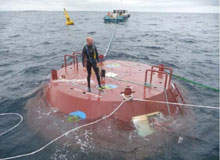
Perth wave power project is located offshore of Fremantle, in the Sepia Depression between Garden Island and Five Fathom Bank, in Western Australia. Carnegie Wave Energy is developing the five megawatt offshore power project to commercially demonstrate its proprietary wave power technology called CETO.
The project will supply renewable electricity to approximately 3,500 households. It will also create 30 jobs. It is estimated it will save 500,000t of greenhouse gas emissions during its operational life.
Synergy will offtake the power produced by the plant. The project location is proximate to the HMAS Stirling Naval Base. Carnegie, therefore, signed a memorandum of understanding (MOU) with the Department of Defence for the development and offtake of power and water for the project.
The project won the Sustainable Energy Industry Excellence and Innovation Developer Award from the WA Sustainable Energy Association in March 2010.
Financial backing for Western Australia’s renewable project
The Western Australian Government funded $12.5m for the project. The offshore infrastructure of the Perth wave energy system comprises of CETO units and high-pressure subsea water pipelines.
The onshore infrastructure includes a power generation system and a grid network connection. Carnegie launched the project in January 2010. The detailed design was completed in December 2011.
The project development is divided into two stages. The first stage has a capacity of two megawatts. It was completed in April 2011. The second stage, with a peak capacity of three megawatts, will be completed in 2013.
The project is backed by $15.4m funding support from the federal and state governments. Lind Partners is investing about $16m in the project through equity.
Construction of the facility offshore of Fremantle
The first stage of construction on the project was completed in April 2011. It is currently being tested as a stand-alone system. It includes a CETO unit, mooring and a telemetry instrumentation buoy.
The instrumentation buoy transmits data related to the unit’s performance to the shore. Stage two of the project is currently under development.
CETO technology at Carnegie Wave Energy’s plant
The Perth Wave Power Plant uses CETO wave technology. Developed by Carnegie Wave Energy, it is a buoyant actuator which comprises of an array of submerged buoys tied to seabed pump units.
The buoys move harmonically when passed over by the waves of water. The unit starts operating when the height of the wave is at least one metre. The motion of the buoys increases the water pressure. The high-pressure water, carried to shore via a pipeline, is used to drive hydroelectric turbines to produce renewable power with zero emissions.
High loads caused by storm waves are dampened within the pump and the actuator self-regulates the amount of energy absorbed from a wave. This enables the device to survive without taking any damage during a storm.
The water carried to the shore can further be used to drive the pumps of water desalination plants, such as reverse osmosis plants. It requires higher than osmotic pressure to drive the pumps of a desalination plant, rather than converting the wave energy to power. Commercial viability of the CETO technology for use in desalination plants was verified in 2011, by Frazer-Nash.
The technology therefore offers more renewable benefits. The CETO system causes no visual impact because it is anchored to the ocean floor and all equipment is submerged. It also attracts marine life, rather than being harmful.
Contractors for Perth’s wave power project
Hatch Engineering is the engineering, procurement, construction and management contractor for the project. Tyco Tamar is responsible for designing the turbine and power generation system. RPS Consulting Engineers and Geomarine are responsible for designing the foundation.
INTECSEA is responsible for designing the pipeline. Boskalis Australia supplied a jack-up rig for drilling the pile foundation for the project.


